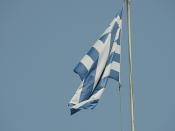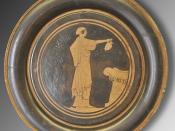In the statue "Doryphorous" by Polykleitos the human form is used as a cultural symbol as this was the reason art was created in the Ancient Greek Classical Period; to highlight their love of the human body and its cultural importance within society. It represents the importance their culture places on physical perfection.
Firstly, the Greek artists believed that a perfect society could be created through truth, justice and beauty, and these ideals were represented through their art forms. As we can see in "Doryphorous", the body is idealized and unblemished and represents this belief of Greek culture; that beauty can be a basis of a great society. Polykleitos has used the human form to represent this cultural aim.
Secondly, the Greeks enjoyed an enlightened legal and political system with intellects and athletes honored. Intellectual and creative life was flourishing and this sculpture is an example of some of the art work produced in response to these intellectual probings.
The human form has been used to represent the advancement in intellect and enlightenment, fascination and study of the human figure.
Thirdly, the distinctly "Greek" idea of beauty is portrayed in "Doryphorous". They believed that beauty was to be achieved through balance, harmony, unity and proportion and all of these elements are present in the sculpture. It celebrates the human form through sculptural beauty. This idea of beauty is an aspect of cultural importance for the Greeks which we are able to know about today because of how they represented these ideals through their artworks.
In conclusion, the sculpture "Doryphorous" by Polykleitos has used the human form as a cultural symbol through representing the importance in Greek society on beauty and displaying this importance with technical skill, emphasizes the intellectual movements of the...


